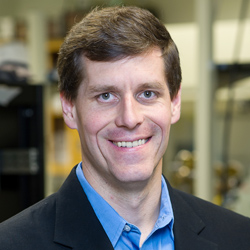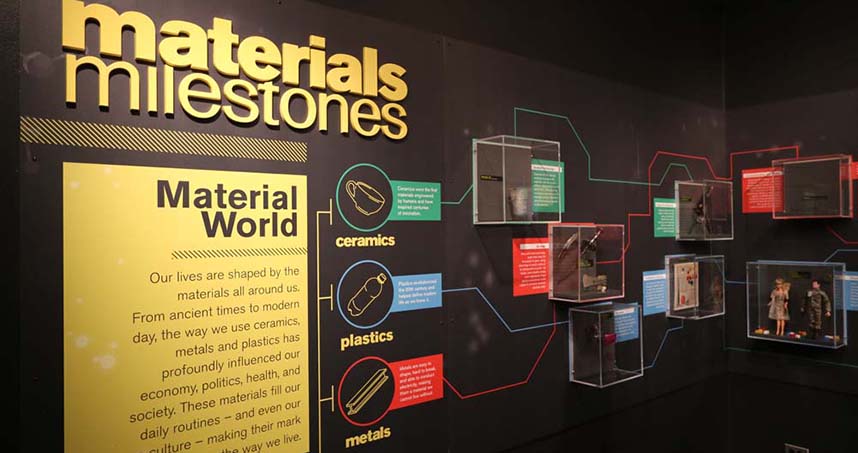Museum of Science and Industry Exhibits Materials Science Research
The exhibit runs through January 21, 2016
Glass beakers in the laboratory of Mark Hersam, professor of materials science and engineering, contain a graphene-based ink that could hold secrets for future scientific and technological breakthroughs. Laced with flakes of ultra-thin carbon that maintain exceptional strength and conductivity, the ink holds the potential to create bendable transistors that could make widespread wearable electronics a reality.
On a flat-screen TV inside Chicago’s Museum of Science and Industry (MSI), the nanoparticles are magnified 100 million times for visitors to see.
The display is part of a new exhibit resulting from three years of planning by the museum and Northwestern’s Materials Research Science and Engineering Center (MRSEC). It marks the biggest project in the decades-long collaboration between the two institutions and is one example of the University’s commitment to bringing its scholarship to the public in ways that are engaging and accessible.
 “It’s amazing to walk through the exhibit on a Saturday afternoon and hear the public engaging in conversations about materials science,” said Hersam, MRSEC director. “The fact that a fifth-grader or 50-year-old can interact with and learn from the information presented is a testament to the quality of MSI and the hard work that faculty, students, and staff at Northwestern contributed to the finished product.”
“It’s amazing to walk through the exhibit on a Saturday afternoon and hear the public engaging in conversations about materials science,” said Hersam, MRSEC director. “The fact that a fifth-grader or 50-year-old can interact with and learn from the information presented is a testament to the quality of MSI and the hard work that faculty, students, and staff at Northwestern contributed to the finished product.”
Inhabiting a gateway space on the museum’s lower level, the Materials Science exhibit opened on March 19 and has the potential of being viewed by more than 1 million visitors before closing January 31. The immersive gallery is bisected by the museum’s main staircase with each side focused on how materials research affects society.
One portion of the show offers visitors a new perspective on the ubiquity of materials science in everyday life, revealing how metals, ceramics, and plastics have evolved to be integral to consumer products. An adjacent gallery focuses on the field’s frontiers and highlights how emerging materials, such as silicon, carbon, and magnetic products, are shaping the future of electronic technologies like computers, tablets, and smartphones. An interactive component allows visitors to design their own magnets from the elements of the periodic table.
The displays feature research findings from Northwestern Engineering faculty, including Lincoln Lauhon, Gregory Olson, and David Seidman.
“Institutions like Northwestern provide a valuable asset in helping verify the information we display while also providing updates on the cutting-edge work taking place within its labs,” said Patricia Ward, director of science exhibitions and partnerships at MSI. “From an outreach perspective, having members of the Northwestern community interact with the public helps show that research isn’t just something that’s already happened; it’s truly ongoing and represents a possible career path.”
The exhibit also provides a look at scientific instruments never before displayed at MSI, including an atomic probe field ion microscope, the tool that first allowed researchers to see materials at an atomic level. The microscope dates back to the 1950s, a decade before MRSEC received initial federal funding. Today, the center is one of the oldest and longest continually funded materials research units in the nation.
“MRSEC’s longevity speaks to our ability to constantly ask new research questions and thus advance the field of materials science and engineering,” said Hersam. “Funded by the National Science Foundation, it’s integral that the center also combine research and education in a way that is accessible to the public. The exhibit at MSI is a terrific example of how successful that process can be.”
